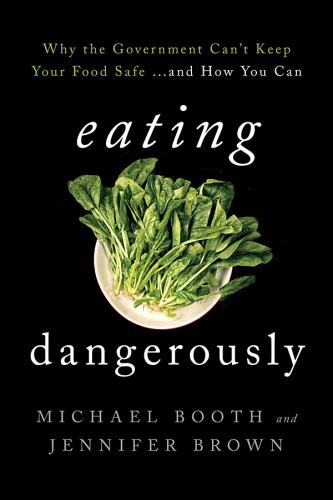
Eating Dangerously
Why the Government Can't Keep Your Food Safe...and How You Can
کتاب های مرتبط
- اطلاعات
- نقد و بررسی
- دیدگاه کاربران
نقد و بررسی

April 7, 2014
Beginning with a chilling reminder about how contaminated cantaloupe killed consumers in 2011, journalists Booth and Brown of The Denver Post present an eye-opening, authoritative account of the everyday dangers in the U.S. food industry and provide short term consumers solutions safer eating. The authors list spinach, peanuts, and eggs as culprits in recent outbreaks of E Coli, Salmonella and Listeria and explore the causes and consequences affecting Americans. Fred Pritzker, a Minneapolis attorney who specializes in food illness cases, deplores the FDA's "willful negligence" of food safety procedures and of criminal prosecution towards the people responsible. But the government can't anticipate the food fads that create challenges for the 2,800 food-related FDA employees reviewing 350,000 food makers and facilities or the 1,800 FDA inspectors checking U.S. imports. With a lax penalty system and the startling statistic that "early 50 million Americans will get food poisoning this year," it pays to be an educated shopper. The authors' thorough examination leads way to complimentary resources and tips for safer eating.

Starred review from April 15, 2014
The Center for Disease Control and Prevention (CDC) estimates that one in six Americans gets sick from food-borne illnesses each year. Of these, 128,000 are hospitalized and 3,000 die. Coauthors Booth and Brown, investigative reporters for "The Denver Post", explain why these numbers are so high and provide advice that will help readers to avoid contributing to these alarming statistics. The authors begin by describing the scope and magnitude of ailments in the United States in a section that reads like a "60 Minutes" expose vivid descriptions of people falling ill, a global food market with inconsistent international standards, and inadequate, sometimes nonexistent, government inspections. What follows this account is common-sense advice for consumers. This segment explains how to choose, handle, and prepare food safely and how to identify the riskiest ingredients (as well as reduce their potential harm). Then the authors examine the intersection between food technology and safety, providing an excellent analysis of arguments and evidence for and against genetically modified products; and discuss the relationship between food safety and local and/or organic fare. Also included is an overview of various food-borne illnesses, including information on transmission, symptoms, treatment, and complications. The book concludes with a handy summary of tips for staying protected. VERDICT Both alarming and empowering, this very useful title will help consumers understand and minimize their risk of falling ill.--Janet Crum, Northern Arizona Univ. Lib., Flagstaff
Copyright 2014 Library Journal, LLC Used with permission.

Starred review from February 1, 2014
More than a little Michael Mooretype scary is this eye-opening expos' of foods, grocery shopping, and government oversight in America. Two Denver Post journalists, who investigated the 2011 deadly listeria outbreak (32 killed by eating cantaloupes), use those same skills of inquiry in preparing an account that every U.S. consumer should read. At the beginning, the authors graphically describe many contemporary food crises, from the 1993 Jack in the Box hamburger issues to horse meat found in IKEA meatballs. Nail-biting aside, they take readers through the constraints faced by the FDA and USDA (in numbers alone, 2,800 FDA employees supervise 350,000 food makers); the methodology that the Centers for Disease control and Prevention and epidemiologists use to figure out illness causes; a perspective on food imports (more than 10 million shipments each year arrive at 320 U.S. ports); and penalties levied on the perpetrators. Most important, though, is the diagnostic and prevention section, keeping families safe (and, yes, sane). Through the authors' eyes, readers will learn how to handle different foods, especially those most prone to bacteria; new, upcoming on-stream technologies that might help stem these outbreaks, from genetically engineered foods to nanotechnology; the five most common gastroenteritis symptoms; and what other manufacturers and agencies are doing to keep us safe. After all, concludes Mile High Organics CEO Michael Joseph, It's really scary to worry your food is going to kill you. (Reprinted with permission of Booklist, copyright 2014, American Library Association.)

























دیدگاه کاربران